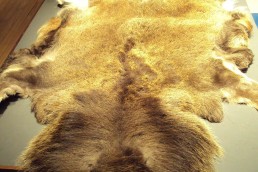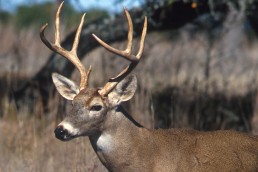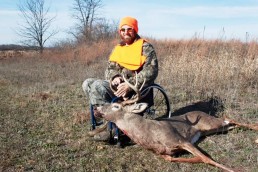You’ve Got Your Deer: What Can You Do with the Skin?
SHARE THIS POST
One question often brought up by hunters with many of the deer that I butcher is, “What can be done with the skin?” Fellows with their first deer looking for a memento of the achievement usually ask. Another question is—if the head’s not worth mounting—is, “Could the skin be made into a rug?”
Of course, it could be done, but it’s not very practical. The hair on a deer, while it acts as a very good insulator on the deer during winter, is very brittle and does not hold up as good as the coat on a fur-bearing animal. You could not cuddle up on a deerskin rug, as the coarse hair would not allow the skin to flex and bend and the coarse hair would be constantly be breaking off.
However, with the hair removed it becomes one of the finest leathers. During the Second World War, there was a need for deerskin leathers. This particular leather when made into gloves remains flexible, especially useful when worn by aviators in the cold at high altitudes. If you can get enough skins they can be made into a leather coat. I’ve had several made and they are comfortable and very durable. The only problem is getting enough skins. Maybe you can get together with others who have deer.
Native Americans used the skins to make much of their clothing when they needed leather without fur, and they had a unique method of treating the skins that was simple and effective.
If you would want to turn your skin into a leather piece, you can do it. And although it’s messy, it is simple to do with what you might have at home.
Are you enjoying this post?
You can be among the first to get the latest info on where to go, what to use and how to use it!
The skin is first soaked in water until the hair can be pushed off. Unlike other skins, a deer hide will lose its hair when soaked in warm water for a few days without ruining the leather. The Native Americans would also use the brains of the animal to break up in water and make a solution that they would soak the leather in until they could push the water through it. You can achieve the same results by soaking the skin in a solution of soapy water. It has to be soap and not detergent—I use Ivory bar soap.
After you can push the water through the skin, wash the skin and remove all of the soap. Then give the skin a light coating of animal fat. I use salt-free butter, and allow the skin to dry.
The skin will turn hard and stiff. Give the skin a light coating of water until it returns to its original soft texture and work and stretch it over the back of a chair or something similar until it dries “soft.” You might have to do this several times. You will now have a peace of beautiful white leather. The only problem is if it gets wet it will dry hard, and again have to be worked. The Native Americans solved this problem by smoking the leather into the “brown” leather you are used to seeing. It will also now be waterproof.
Native Americans would also stretch the hairless untreated skins on a frame until it dried. They would then slice the skin into narrow shoestring-size strips, which was and is called “rawhide.” These rawhide strips would be used to tie and bind anything together, and make up for a lack of nails. If the rawhide strips were applied wet, they would shrink as they dried and become a strong attachment.
For hunting or deer preparation questions, Howie Switalla may be reached at 773-763-3317.
MWO
SHARE THIS POST
Did you enjoy this post?
You can be among the first to get the latest info on where to go, what to use and how to use it!
Howie Switalla
For hunting or deer preparation questions, Howie Switalla may be reached at 773-763-3317.



